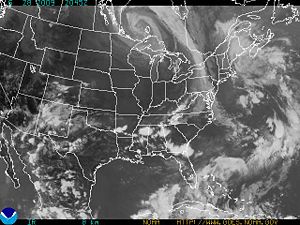Geostationary Operational Environmental Satellite
Geostationary Operational Environmental Satellites (GOES) are optimized for long-term observation and pattern/signature recognition of phenomena in Earth's atmosphere and on Earth. Their geosynchronous orbits allow them to scan the same field of view for long periods of time. Like military spectroscopic MASINT sensors, they combine electro-optical viewing in multiple wavelengths, many not visible to the human eye.
One obvious trigger event is detecting severe storms and forest fires. In addition, they help in rainfall and snow cover estimation, which can predict floods and winter storms. They track the movement of sea and lake ice.
They also have a critical role in the Global Maritime Distress and Safety System, carrying some of the transponders of the multi-satellite COSPAS-SARSAT system that receives and relays signals from emergency position indicating radio beacons (EPIRB). These satellites also broadcast a precision time reference that may be available when a GPS signal is not.
While GOES produces images that are understandable to the human eye, they are not taken with an instrument corresponding to a camera, but from radiometers that scan points along a grid, measurements from which are constructed into a human-viewable graphic as well as information for mumerical processing. The basic picture comes from the Imager, which is supplemented with finer detail from the Sounder. Imager data includes white-light and infrared luminosity, and a scan that correlates to moisture. Sounder scanning adds information on atmospheric temperature and moisture profiles, surface and cloud top temperatures, and the distribution of atmospheric ozone.[1]
The Sounder and Imager both provide full earth imagery, sector imagery containing the edges of earth’s disk, and area scans of local regions. Nineteen spectral bands, one visible light and eighteen infrared light, seven in the (seven in the longwave IR, five in the midwave, six in the shortwave) combine to produce products of vertical temperature profiles, vertical moisture profiles, layer mean temperature, layer mean moisture, total precipitable water, and the lifted index (a measure of stability).
Imager
As mentioned, the Imager is not a camera, but a multispectral radiometer that gives a point-by-point luminosity from which images can be constructed. It operates in one visual and four infrared wavelengths, one optimized for moisture sampling. Cloud imagery is available to users in mapped format (available for each channel) as well as the familiar GOES projection sectors. Two composite images, visible-infrared and infrared-water vapor, are also produced.
The instrument uses a "a servo driven, two-axis gimbaled mirror scanning system in conjunction with a Cassegrain telescope, the Imager's multispectral channels can simultaneously sweep an 8-kilometer (5 statute mile) north-to-south swath along an east-to-west/west-to-east path, at a rate of 20 degrees (optical) east-west per second. This translates into being able to scan a 3000 by 3000 km (1864 by 1864 miles) "box" centered over the United States in just 41 seconds. The actual scanning sequence takes places by sweeping in an East-West direction, stepping in the North-South direction, than sweeping back in a West-East direction, stepping North-South, sweeping East-West, and so on."[2]
Sounder
GOES' Sounder is another servo-driven radiometer which contributes to images, but with finer detail than the Imager.
The GOES I-M Sounder features more spectral channels, higher spatial resolution (8 kilometers, 5 statute miles), and increased sensitivity for high quality soundings than are currently available. It is capable of stepping 1 visible and 18 infrared channels in a north-to-south swath across an east-to-west path.
References
- ↑ Space Systems-Loral (19 November 2001), GOES I-M DataBook, National Aeronautics and Space Administration
- ↑ GOES Imager Instrument, National Atmospheric and Oceanographic Administration
